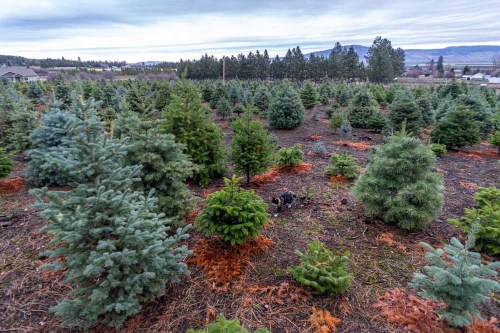Drought scorches trees, affects Christmas tradition in years to come
Published 5:00 am Tuesday, December 7, 2021

- View of the Donivan Tree Farm, La Grande, on Nov. 30, 2021. The Donivans saw a large number of their seedlings and saplings scorched by the summer heat wave and drought, though nearly all of the market ready trees survived.
LA GRANDE — A scorching summer and persistent drought in Oregon has stressed young saplings and seedlings of Christmas trees from the Willamette Valley to Eastern Oregon. Those environmental conditions have exacerbated an already strained industry that was just starting to recover from a Christmas tree shortage that was decades in the making.
Due to a large surplus in trees in the early to mid 2000s, many Christmas tree growers had one unprofitable year after another, leading the farmers to seek out other avenues of revenue as prices plummeted for their product.
Trending
“Between growers not planting — that stayed in the businesses — the number of trees that were going into the ground from 2006 to 2007 wasn’t enough to sustain the demand that would be out there 10 years in the future,” said Greg Smith, owner of Molalla Tree Farms, which grows Christmas trees on nearly 200 acres in Clackamas County. “So, in 2015, you started seeing the market tighten up for supply, and then people have been planting again, but we’re still — it’s such a long process to grow a Christmas tree. It’s a 10-year project to get a marketable tree.”
Smith had lost many of his younger saplings and seedlings this year due to the high temperatures in the summer that pushed the mercury to more than 110 degrees in some parts of the state. Drought, rising gas prices, labor shortages and heat waves conspired to reduce the already low supply of Christmas trees this year, and the effects of the heat wave are just the beginning.
“We lost basically our entire plantings this year, now we’ve got another big hole that’s going to suck up any excess that would have been in the future,” Smith said, speaking about the Christmas industry as a whole.
Tim Donivan, who runs the Donivan Tree Farm in La Grande with his wife, Loraine Donivan, said the drought compounded the problem regarding the shortages.
“There was a glut of trees 15 years ago and the price went really low,” Tim Donivan said, “and assuming a certain amount of farms converted into wine production, so that changed the supply balance, and this summer with the drought certain trees turned red and aren’t on the market.”
The Donivans have been running a tree farm since their first planting in 1979. Their 3.5-acre property is filled with trees of varying ages and species. Many of the younger trees had been scorched by the summer heat wave, leaving the saplings to resemble the sickly tree from the animated TV classic “A Charlie Brown Christmas.” Older trees largely survived the onslaught of record-breaking temperatures, though a few trees succumbed to the heat while other trees saw only a smattering of reddened needles and crispy branches.
Trending
Loraine Donivan described this year’s weather conditions as highly unusual, and said the heat and drought prevented the trees from developing root structures that would help them weather the dry conditions.
“We lost a lot of the seedlings we planted this spring, and I’m sure that was the case for other growers too,” she said. “We went through and spot watered every tree, including every seedling five times through the summer, but we still lost a large percentage of this year’s seedlings — half of what we planted.”
Oregon leads the nation in Christmas tree production, with exports fueling an industry worth just more than $100 million, according to statistics from the National Agricultural Statistics Service. According to the Capital Press, Oregon grows nearly one-third of all U.S. Christmas trees. Most of the Christmas tree farms reside in or near the Willamette Valley where conditions are prime for pines.
According to Loraine Donivan, trees in Eastern Oregon take longer to grow than those in the Willamette Valley, with the average growth time of 10-12 years for an Eastern Oregon Christmas tree, as compared to the eight to 10 years in the Willamette Valley.
“We’re a lot higher and drier, and they’re a lot more temperate and moist,” Loraine Donivan said.
And while the Willamette Valley is poised to exit its drought starting next year according to National Oceanic and Atmospheric Administration data, the dry conditions for Eastern Oregon will persist for at least one more season. That means local Christmas tree growers will continue to struggle with their crops in the years to come.
“We’re just going to have to replant more next spring and hope we don’t have another weather cycle like that,” Loraine Donivan said.
Still, the Donivans contend they have more than enough trees to supply buyers in the Grande Ronde Valley looking to cut down their own tree for Christmas. Tim Donivan said the farm has “more than we did last year.”









